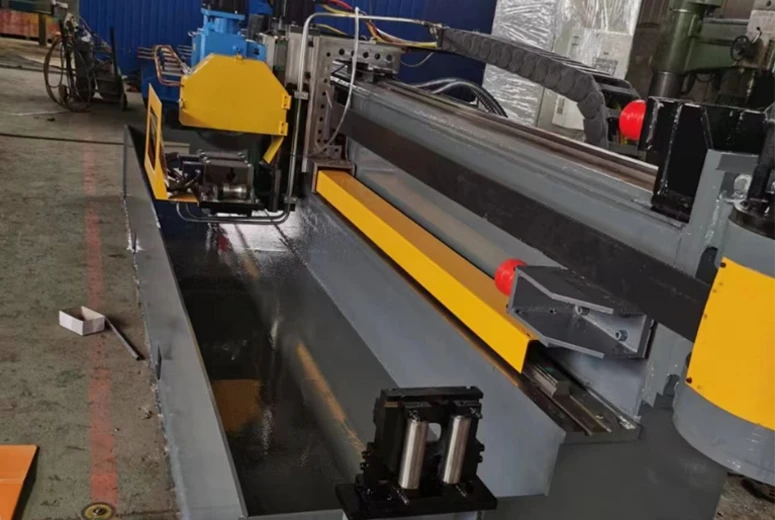pallet decoiler
Understanding Pallet Decoilers Efficiency in Material Handling
In today's fast-paced manufacturing and construction environments, efficiency is paramount. One of the essential tools that facilitate this efficiency is the pallet decoiler. This device is designed to unwind and dispense coils of material, such as wire, banding, or other rolled goods, quickly and safely, helping businesses improve their operational workflows.
What is a Pallet Decoiler?
A pallet decoiler is a specialized tool used to handle metal coils and similar materials that are typically stored on pallets. The primary function of a decoiler is to unroll or dispense these materials in a controlled manner, allowing for easier handling during manufacturing processes. These devices can vary in size and capacity, accommodating different coil weights and diameters depending on the needs of a particular industry.
Pallet decoilers are generally equipped with mechanisms to secure the coil, ensuring it unrolls without tangling or damaging the material. This is particularly important in sectors such as automotive, aerospace, and construction, where material integrity is critical.
Benefits of Using a Pallet Decoiler
1. Increased Efficiency One of the most significant benefits of a pallet decoiler is its ability to streamline the material handling process. By automating the unwinding of coils, workers spend less time wrestling with heavy and cumbersome materials, allowing them to focus on more critical tasks.
2. Safety Improvements Manual handling of heavy rolls can pose a significant safety risk to employees. The inherent design of a decoiler minimizes the need for manual lifting, which reduces workplace injuries and promotes a safer work environment.
3. Improved Material Flow Decoilers facilitate a smoother workflow in production lines. They help maintain a continuous supply of material, which is crucial for processes requiring constant input, such as automated feeding systems in manufacturing.
4. Versatility Many pallet decoilers are adaptable to a range of materials and coil types. They can accommodate different coil sizes and weights, making them suitable for various industries—from manufacturing to logistics.
pallet decoiler

5. Reduced Waste Advanced decoiler systems can help minimize material waste by ensuring that coils are unrolled efficiently and cleanly. This precise handling reduces the risk of material damage, leading to cost savings over time.
How to Choose the Right Pallet Decoiler
When selecting a pallet decoiler, it is essential to consider several factors to ensure that the equipment meets your specific needs
- Load Capacity Assess the weight and size of the coils you typically handle. Ensure that the decoiler can safely accommodate these specifications.
- Material Type Different materials may require unique handling features. Be sure the decoiler you choose is designed for the type of material you work with.
- Ease of Use Look for features that enhance user-friendliness, such as easy coil loading systems and controls.
- Mobility In some cases, it might be beneficial to choose a mobile decoiler, allowing for flexibility in workspace arrangements.
- Build Quality and Reliability A robust design will ensure that the decoiler lasts longer and performs consistently in harsh industrial environments.
Conclusion
In conclusion, pallet decoilers play a crucial role in enhancing efficiency and safety in material handling. By automating the unwinding of coils, they help businesses streamline their operations, reduce workplace injuries, and minimize waste. As industries continue to evolve, adopting advanced tools like pallet decoilers will be essential in maintaining competitive advantages in an increasingly demanding market. Investing in the right decoiler not only optimizes workflows but also fosters a safer and more productive work environment.
-
High Frequency Straight Seam Welded Pipe Production Line-BzZhou Xinghua Machinery Equipment Manufacturing Co., LTD.|line pipe steel&welded gas pipeNewsJul.30,2025
-
High Frequency Straight Seam Welded Pipe Production Line-BzZhou Xinghua Machinery Equipment Manufacturing Co., LTD.|High Precision&Automated SolutionsNewsJul.30,2025
-
High Frequency Straight Seam Welded Pipe Production Line - BzZhou Xinghua Machinery Equipment Manufacturing Co., Ltd.NewsJul.30,2025
-
High Frequency Straight Seam Welded Pipe Production Line-BzZhou Xinghua Machinery Equipment Manufacturing Co., LTD.|Precision Welding, High EfficiencyNewsJul.30,2025
-
High Frequency Straight Seam Welded Pipe Production Line|BzZhou Xinghua|Precision Welding&EfficiencyNewsJul.30,2025
-
High Frequency Straight Seam Welded Pipe Production Line - BzZhou Xinghua|Precision Engineering&EfficiencyNewsJul.30,2025


